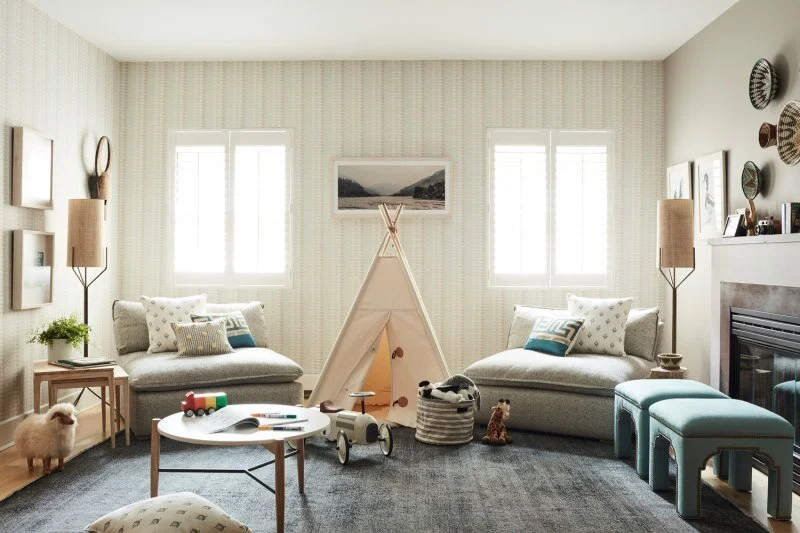Balancing functionality and aesthetics can be tricky when designing a home that caters to children. Parents often fear that creating kid-friendly spaces means giving up on sophistication, but that doesn’t have to be the case. With the right planning, you can design rooms that are safe, playful, and still elegant. Much like personal expression on hiddenfacedps.com, thoughtful interior design can reflect both your personality and your family’s needs without compromise.
Start With Durable And Stylish Materials
One of the smartest ways to achieve balance is by selecting durable yet stylish materials. Floors, furniture, and fabrics in family homes endure plenty of wear and tear, so investing in stain-resistant rugs, washable slipcovers, and scratch-proof surfaces is key.
Instead of sacrificing beauty, look for chic finishes that are practical. For instance, leather sofas, high-quality vinyl, or even performance fabrics allow parents to maintain a polished look while still being able to wipe away spills with ease.
Many parents research options through resources like the business directory of Australia, where suppliers and brands offer materials that balance practicality with design. This helps ensure that family-friendly solutions don’t mean compromising on elegance.
Incorporate Storage Solutions That Blend In
Clutter is one of the biggest challenges in kid-friendly spaces. Toys, books, and art supplies often take over, making it hard to keep rooms looking neat. The solution lies in creative storage. Built-in cabinets, stylish baskets, and multipurpose furniture such as ottomans with hidden compartments can store items while blending seamlessly with your décor.
The key is to create a home where everything has its place, but nothing looks out of place. By disguising storage as part of the overall design, you reduce chaos while keeping a sophisticated aesthetic.
This harmony of practicality and beauty echoes the balance of emotions often captured in emotional sad shayari, where layers of meaning coexist—just as functionality and style can exist in the same space.
Choose A Versatile Color Palette
Color plays a significant role in shaping spaces for both kids and adults. While bright, bold hues appeal to children, neutral or muted tones often appeal to adults seeking a more sophisticated look. The trick is to create a versatile palette that accommodates both.
Walls painted in soft neutrals can provide a calm backdrop, while pops of color can be introduced through removable décor items like cushions, rugs, and wall decals. This way, spaces can grow with your children and adapt easily as tastes change.
Balancing lively and elegant colors ensures that your rooms remain stylish while still being welcoming to kids of all ages.

Focus On Flexible Furniture
Flexibility is another cornerstone of stylish yet kid-friendly spaces. Choose furniture that can adapt as your child grows. Convertible cribs, extendable tables, or modular sofas not only save money but also allow your home to evolve without constant redesigns.
Investing in timeless furniture pieces means you won’t need to completely overhaul your home every few years. Instead, you can simply update accents, storage, or play areas as needed.
When families search listings in an Australia home directory, many pay attention to whether a property can accommodate flexible layouts—a growing demand that emphasizes the need for adaptable designs.
Add Playful Elements With Subtlety
Kids need areas where they can play and feel free, but this doesn’t mean your living room has to look like a toy store. Integrate playful elements in subtle ways. Chalkboard walls, reading nooks, or play tables tucked into corners allow kids to enjoy spaces without overwhelming the design.
Even decorative touches like whimsical art or themed rugs can make a room kid-friendly while maintaining elegance. These design elements should feel like thoughtful parts of the home rather than afterthoughts.
By blending fun into a stylish environment, your home can remain both functional and visually appealing.
Safety Without Compromise
Safety is always a priority in family homes, but it doesn’t have to clash with style. Rounded-edge furniture, secure storage for sharp objects, and non-slip rugs can all be integrated without making a room feel clinical.
Window treatments like cordless blinds or layered curtains can protect children while still adding sophistication to a space. Similarly, baby gates and corner protectors now come in sleek designs that blend in with modern interiors.
Today’s market offers countless products that balance safety and design, ensuring families don’t have to choose between the two.
The Role Of Shared Spaces
One of the greatest joys of family homes is shared living. Designing communal spaces that accommodate both kids and adults is essential. Open-plan living rooms with designated play zones or dining areas that double as homework stations allow families to stay connected while pursuing different activities.
Restaurants and cafés often serve as inspiration here. Just as families look for detailed Australia restaurant reviews before visiting places that suit both adults and kids, homeowners are adopting design strategies that balance sophistication with family-friendliness in shared spaces.
Why Small Contributions Matter?
Designing kid-friendly spaces isn’t just about big renovations—it’s often about the small details. Choosing washable curtains, introducing greenery that’s safe for children, or simply rotating décor items seasonally can refresh spaces without major expense.
Similarly, sharing experiences with other parents, whether in community forums or through opportunities like a guest post, can inspire fresh ideas and creative solutions. Learning from others ensures your designs continue to evolve while meeting both aesthetic and functional needs.
Final Thoughts
Creating a kid-friendly home doesn’t mean giving up on style. With durable materials, clever storage, flexible furniture, and versatile color palettes, you can design spaces that reflect elegance while keeping family needs in mind. Safety, playfulness, and shared living all contribute to making homes both functional and beautiful.
Ultimately, it’s the balance of small details and intentional choices that make the biggest difference. Just as digital expression reflects personal identity, your home design can reflect both style and the joy of family life—without compromise.

